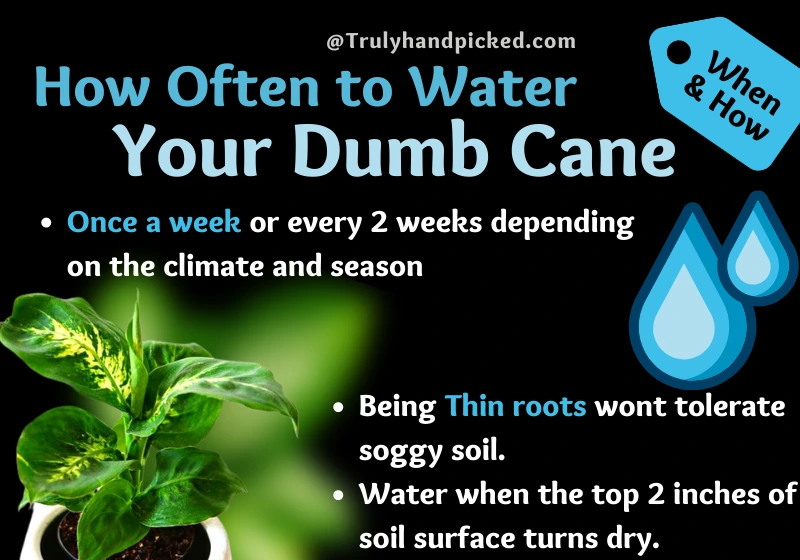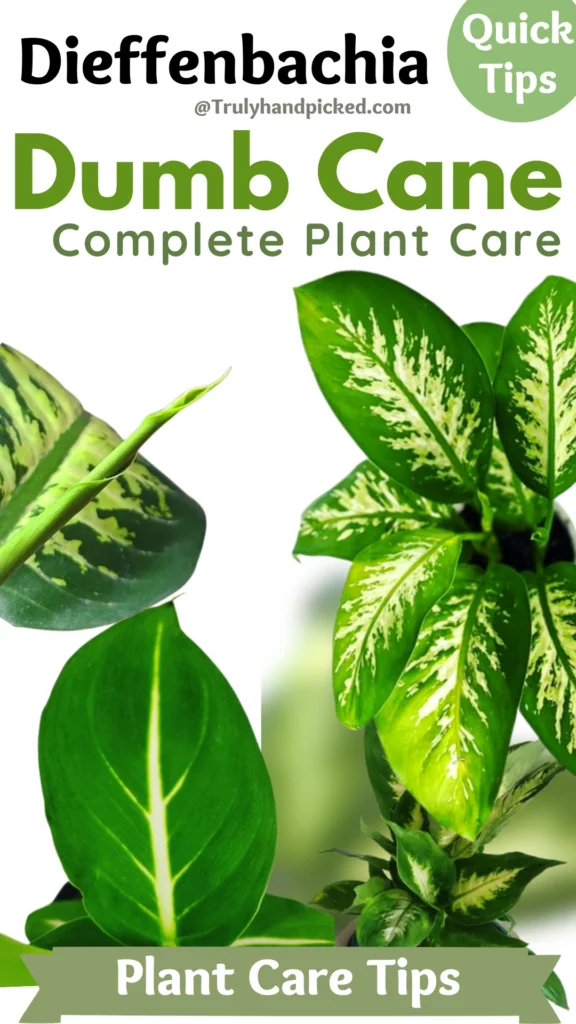
Dumb Cane Plant Complete Care:
Dieffenbachia aka dumb cane or leopard lily is an attractive houseplant with big variegated foliage. There are two famous types of dieffenbachia species we usually pick to cultivate indoors- 1) Dieffenbachia seguine and 2) Dieffenbachia amoena. Both species are easy to maintain and claim only some basic growing essentials to thrive fully. Here are some quick tips in this regard-
Soil, Fertilizer, and Watering Schedule
- Soil: This species of ornamental houseplant is adaptable to any kind of normal potting mix. Make sure the soil is loose enough and drains well with a slightly acidic quality. A potting soil, balanced with peat moss and perlite would be a great choice here.
- How often to water: Dumb cane plants are very particular about their water needs. Try to maintain a good watering schedule that keeps the soil evenly moist but not soggy. Once a week or every 2 weeks depending on the climate and season would be the best.
- Fertilizer: dieffenbachia plants are quite a high feeder and they need regular fertilization during the growing seasons. Feed your indoor dumb cane plant with a balanced all-purpose fertilizer in a 20-20-20 NPK ratio every 4-5 weeks.

Light Requirements, Temperature, and Pruning
- Sun Exposer: Being a perfect houseplant, a dumb cane plant thrives best while placed under the sun with partial shade. Try to provide your plant with bright indirect light for 6-8 consisting hours every day.
- Temperature: This plant prefers moderately warm weather. So, try to keep the plant between 65° to 75° F. It can do perfectly well at normal room temperature, just make sure you never let the temperature below 59° F, ever.
- Climate: This big-foliage plant loves moisture in the air where they grow. It helps to keep their leaves tender and waxy naturally. Hence, you must keep the humidity level of the room always high with 60% humidity to provide a dieffenbachia plant with the best climate.
- Pruning: A healthy dumb cane plant could grow up to 3-10 feet long with 2-3 feet in width. Pruning is essential for such big-foliage plants to keep them healthy and roomy. Wait till the spring and trim off only the portions that seem discolored or leggy or infected in the plant.
Repotting and Dealing With Pests
- Repotting: Roots of this plant always want proper space along with the perfect moisture. So, you must let the root-bound have enough space with their growing period. Try to repot it every 2-3 years with a 3-4 inches bigger planter.
- Dealing with Troubleshoots: Always be attentive towards your growing dumb cane plant and try to solve all problems at their primary stage, once they occur. Leaves discoloration, the infestation of spider mites, attack of mealybugs, leggy stems, etc. are some common issues you may face with a growing dieffenbachia plant.

Why is My Dieffenbachia Tall and Leggy?
Some causes force your healthy dumb cane plant to become leggy. You must look out for its hidden reason to cure it permanently of its roots-
Reasons:
- Insufficient light, if you place your plant in a low-light area for long with no-sun exposer
- Soggy soil, due to overwatering. It happens, when the soil of your planter gets suffocated for unnecessary watering with a poor drainage system
- Rootbound due to bigger plater. This could happen when you provide excessive wide space to the roots of a growing dumb cane plant
- Improper temperature. If you keep your planter in a room where the temperature is higher than 85° F or lower than 59° F
How to Fix:
- Keep your planter where your plant can grab indirect but bright sunlight consistently
- Placing the planter in a north-facing window could give you the best outcome
- Water it only when the top 1-2 inches of the soil turns dry
- Check for the perfect drainage system, every time you water it
- Trim off the top overgrown parts periodically
- Keep the temperature of the room always suitable for a growing dieffenbachia
- And always sow your plant in a planter with perfect size, neither bigger nor smaller
Why is My Dumbcane or Dieffenbachia Turning Yellow?
Like leggy form, a dieffenbachia plant also may face the issue of yellowing leaves during its long growing period. Fortunately, you can reverse those leaves into green again, if you catch them in time with these smart tricks. These tips will also aid you to let the foliage discolor again soon-
Causes:
- Overwatering
- Underwatering or no watering at all
- Improper light exposer
- Temperature fluctuation
- Low humidity
- Bad drafts
- Nutrient deficiency
- And untreated pests and bugs
How to Fix:
- Let the topsoil dry between watering and make sure you use well-drained soil with a good draining planter
- Don’t let the potting soil unwater for more than 10 days
- Place the planter where it can get the exact amount of bright but indirect light through the sun with partial shade
- Maintain the growing temperature accordingly and don’t let it fluctuate frequently
- Never place the planter in a room with low humidity or dry condition for long
- Keep your planter away from drafts like heating vents, air conditioning devices, leaky windows, etc.
- Fertilize your plant consistently throughout the growing seasons. Make sure the fertilizer is rich in nitrogen and phosphorus to avoid this yellow leaves issue permanently
- Look for the infestation of mealybugs, scales, and spider mites on a growing dieffenbachia plant, which is very common, and apply the remedy shortly.
Dumbcane or Dieffenbachia Propagation:
Despite being a huge houseplant, you can propagate dieffenbachia or dumb cane plant very effortlessly even in several ways. Let’s find out the best methods of regrowing a dieffenbachia plant at home-
Propagation Through Stump:
- Find the leggy but healthy shoots out of a fully grown dieffenbachia plant first
- Cut that part out with a disinfected cutter and cover the end section with rooting hormone
- Now, plant the stump in a prepared planter with suitable potting soil and mist it properly
- Keep it in a moderately humid place with normal room temperature for a couple of weeks
- Once the new leaves appear from the top, remove the older leaves and let them thrive accordingly.
Propagation Through Cutting in Water:
- Cut out a stem about 4-5 inches long along with the nod section
- Remove the leaves from its bottom section and keep them in a glass with filtered water
- Let the end part completely submerge into the water and cover the glass with a plastic bag
- Keep changing the water every 6-7 days until the new roots sprout
- Once the new root reaches 2-3 inches long, sow it in a planter prepared with proper potting mix.
Growing From Cutting in Soil:
- To do this process, you need to dip the end of the stem cutting in a powdered rooting hormone first
- Now, lay it in a planter full of damp potting soil in a horizontal condition
- Wait for 4-5 weeks, once the new root initiates, fresh leaves will sprout eventually
- You just need to fulfill the entire growing requirements of that newly sprouted plant to get the best thriving version of it.
Propagation Through Division:
- To apply this process, wait till the period of repotting
- During the session of replantation, divide offsets of the plant carefully along with their roots
- Prepare different plater with preferred potting mix and sow each division individually in different planters
- Now just keep the planters in the proper place with a preferable climate to boost healthy growth in your newly planted divisions.

Is Dumbcane or Dieffenbachia Plant Poisonous?
Unfortunately, this exclusive-looking houseplant is completely poisonous for mammals and house pets. Ingestion of the dieffenbachia plant can be dangerous for both humans and animals, however, it turns completely fetal for mammals.
Why is it Poisonous?
The Dumbcane plant contains a needle-like segment that contains oxalate crystals in the form of oxalic acid. Leaves, stems, sap, and even roots of this plant contain this venomous property themselves.
Reactions:
If your pet or any kid gulps any part of this plant in mild to a large amount, they may face these allergic reactions immediately-
- Mouth irritation
- Burning sensation in the throat through the mouth
- Nausea
- Vomiting
- Difficulty swallowing
- Hoarseness
- Drooling
- Restlessness
- Loss of appetite
- unconsciousness
- Blistering in tongue
- Skin itching
- General redness
- Eye pain
- And even damage in the cornea
We recommend seeking medical help instantly before things get out of your control. Don’t forget to keep your house pets or babies or toddlers away from the plant, if you have any one of them along with a growing dieffenbachia plant in the house!
